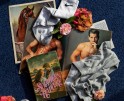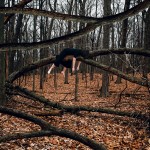Samantha Geballe: Self Untitled
 Samantha Geballe has a dilemma. She is a fearless, talented artist who continues to examine her life, her body, and her journey through self-portraiture. She has powerfully documented her physical and psychological struggle with weight and self-identity. But she is not interested in being categorized or being compared or being a spokesperson for what she is going through. First and foremost, she is an artist, and she wants us to focus on her art. The problem is, her art is based on who she is and for most, it’s hard to separate the art and the subject and that’s the dilemma. But no matter, Samantha can encapsulate emotions: yearning, anger, longing, fear, loneliness and create potent black and white representations of those emotions that are raw and real and remarkable. Her two-part series, Self-Untitled, explores the perceived perspective of society and acceptance of oneself. Samantha is at the beginning of what will undoubtedly a significant photographic career and will soon be attending Photolucida and Review Santa Fe.
Samantha Geballe has a dilemma. She is a fearless, talented artist who continues to examine her life, her body, and her journey through self-portraiture. She has powerfully documented her physical and psychological struggle with weight and self-identity. But she is not interested in being categorized or being compared or being a spokesperson for what she is going through. First and foremost, she is an artist, and she wants us to focus on her art. The problem is, her art is based on who she is and for most, it’s hard to separate the art and the subject and that’s the dilemma. But no matter, Samantha can encapsulate emotions: yearning, anger, longing, fear, loneliness and create potent black and white representations of those emotions that are raw and real and remarkable. Her two-part series, Self-Untitled, explores the perceived perspective of society and acceptance of oneself. Samantha is at the beginning of what will undoubtedly a significant photographic career and will soon be attending Photolucida and Review Santa Fe.
Samantha, a California native, was born and raised just south of San Francisco in a small town called Woodside. Samantha was raised by her grandparents, and her grandmother consistently encouraged her to create drawings and paintings. Her ability to express herself through a creative form is in her nature, and she has been producing art in different mediums since early childhood. The evidence can be seen scattered throughout her childhood home. Samantha is currently based in Los Angeles, CA.
Phase One
This is not another fat kid’s story. There are times when I do assume that role, but it does not define me. I don’t have the body I have for no reason, but it would be all too easy to extend blame. What people don’t often see are the functions of obesity. I hide behind my size, mask vulnerabilities and create walls as a way to protect myself. Something I have learned and portray in my art is that being vulnerable, and forming connection have created new function and even healing. I share my body and my story not as a way to seek pity or define myself as a number, but as a venue for a viewer to say “I’ve been there too.” I take self-portraits as a way to reverse perspective from how I see myself to my interpretation of how I am seen by others. This body of work represents the feeling that interpretation provokes. This work does not exclusively relate to obesity or size. It is also about misuse of a human and not being seen as such. This is a body of work that requires fearlessness. I have had to set my fears aside in order to convey my intended message. I think judgment derives from lack of information, meaning – when we don’t know the whole story, we fill in the missing pieces with our own knowledge. I think the reason we fight as a community is that we dissociate from humanity, not allowing ourselves to really know a person is a person.
I take self-portraits as a way to reverse perspective from how I see myself to my interpretation of how I am seen by others. This body of work represents the feeling that interpretation provokes. This work does not exclusively relate to obesity or size. It is also about misuse of a human and not being seen as such. This is a body of work that requires fearlessness. I have had to set my fears aside in order to convey my intended message. I think judgment derives from lack of information, meaning – when we don’t know the whole story, we fill in the missing pieces with our own knowledge. I think the reason we fight as a community is that we dissociate from humanity, not allowing ourselves to really know a person is a person.  Regardless of appearance, everyone has been made to feel small at some point. My hope is to generate a relationship between myself and others through my work, and I ask you, as a viewer, to look for the similarities instead of the differences.
Regardless of appearance, everyone has been made to feel small at some point. My hope is to generate a relationship between myself and others through my work, and I ask you, as a viewer, to look for the similarities instead of the differences.
Phase Two
A shift happened. I wasn’t expecting it and then I saw it start to happen. I tried to stop it and I couldn’t… and then it was just here. And that is when my feelings about the work changed.  Here’s how it happened: When I began my self-portrait series, it was an expression of my pain and anger, a journey through self-acceptance, and a way to bridge the gap between myself and others. Now that I feel like less of a target, I can see that I photographed myself to cope. It made me feel better.
Here’s how it happened: When I began my self-portrait series, it was an expression of my pain and anger, a journey through self-acceptance, and a way to bridge the gap between myself and others. Now that I feel like less of a target, I can see that I photographed myself to cope. It made me feel better. I am realizing that this series helped me process my own denial about my eating disorder. I had once again lost control of my weight/eating and unknowingly, my dysfunction became my muse. This insight is what I initially resisted. I didn’t know if I was ready to move away from feeling angry. It felt good to scream as loud as I could in a silent photograph. I am upset about that phase ending, but it is over. I try to go back and can’t. It doesn’t feel real anymore.
I am realizing that this series helped me process my own denial about my eating disorder. I had once again lost control of my weight/eating and unknowingly, my dysfunction became my muse. This insight is what I initially resisted. I didn’t know if I was ready to move away from feeling angry. It felt good to scream as loud as I could in a silent photograph. I am upset about that phase ending, but it is over. I try to go back and can’t. It doesn’t feel real anymore. I don’t want it to seem like my “shift” happened because I had gastric bypass. It honestly just materialized that way. My life looks radically different now than it did before surgery and I’m realizing it will look radically different again soon. A new chapter is beginning in my life and I have to embrace it whether I like it or not. This is the direction of my work.
I don’t want it to seem like my “shift” happened because I had gastric bypass. It honestly just materialized that way. My life looks radically different now than it did before surgery and I’m realizing it will look radically different again soon. A new chapter is beginning in my life and I have to embrace it whether I like it or not. This is the direction of my work. There is absolutely no denying the fact that life is easier at a smaller, healthier size. I feel privileged to be able to cross my legs. And not worry so much about seating situations, fitting in chairs, and fitting in general. The world felt unmanageable at that size. If only I had known then that it would all change and I would still be myself.
There is absolutely no denying the fact that life is easier at a smaller, healthier size. I feel privileged to be able to cross my legs. And not worry so much about seating situations, fitting in chairs, and fitting in general. The world felt unmanageable at that size. If only I had known then that it would all change and I would still be myself. This phase of self-portrait work is about embracing change. It’s about learning to navigate life without the dysfunction and defense of excess weight. It’s about learning to live in a new body. It’s about awareness of time and what changes time will bring. The weight has been a distraction from life. It’s easy to lose sight of priorities when size monopolizes your daily living. As this series has started to develop, so has my clarity.
This phase of self-portrait work is about embracing change. It’s about learning to navigate life without the dysfunction and defense of excess weight. It’s about learning to live in a new body. It’s about awareness of time and what changes time will bring. The weight has been a distraction from life. It’s easy to lose sight of priorities when size monopolizes your daily living. As this series has started to develop, so has my clarity. After surgery, everyone thought I would just be happy and all my problems would disappear. The odd thing is that I feel left with myself now more than ever. There’s no fantasy or smoke and mirrors. It’s just real.
After surgery, everyone thought I would just be happy and all my problems would disappear. The odd thing is that I feel left with myself now more than ever. There’s no fantasy or smoke and mirrors. It’s just real.
Posts on Lenscratch may not be reproduced without the permission of the Lenscratch staff and the photographer.
Recommended
-
Gadisse Lee: Self-PortraitsDecember 16th, 2025
-
Katelyn Lux Brewer: TICSeptember 7th, 2025
-
BEYOND THE PHOTOGRAPH: A Mindfulness Practice with Christine CluffApril 25th, 2025
-
Riley Goodman: Art + History Competition Honorable Mention WinnerApril 4th, 2025

































































